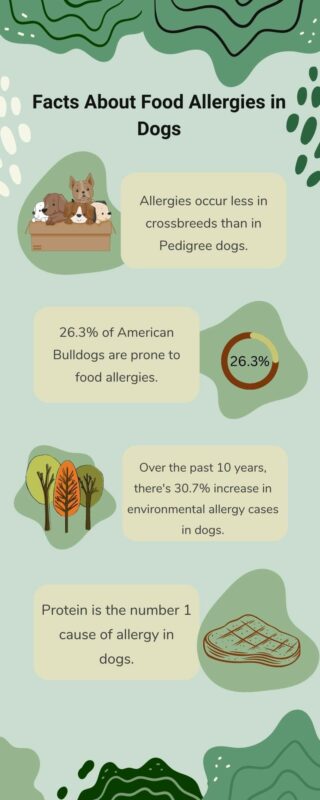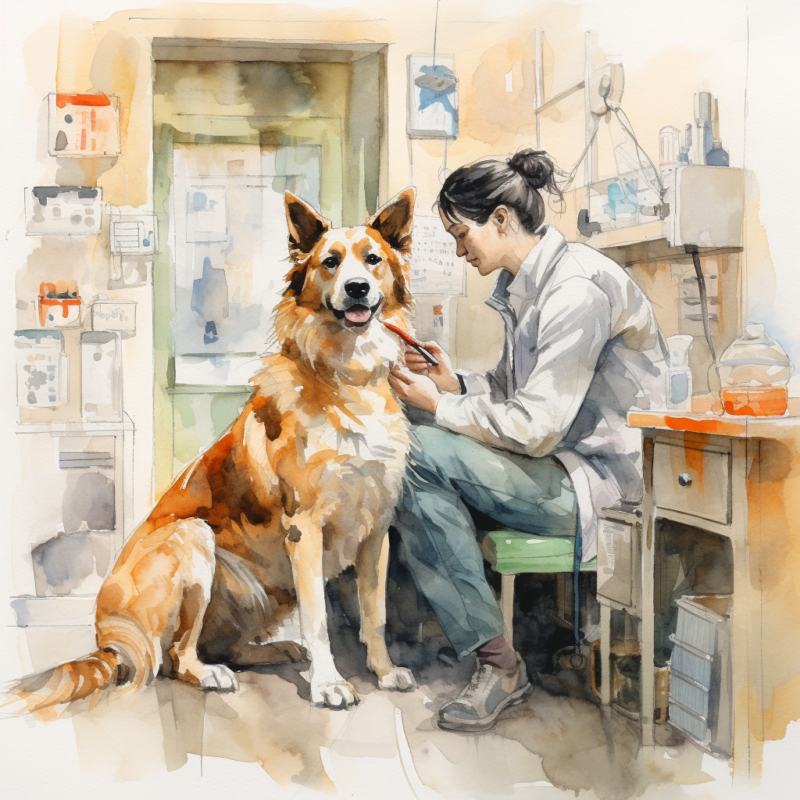What are Food Allergies in Dogs?
What is it?
How is it Treated?
Breed Predispositions
Boxers Bulldogs Cocker Spaniels Dalmatians German Shepherds Golden Retrievers Labrador Retrievers Lhasa Apsos Miniature Schnauzers Shar Peis
Introduction
Every evening, like clockwork, Paul would prepare a wholesome meal for his cherished Boxer, Rocky. They had established a comforting routine, and Paul took pride in providing high-quality nutrition for his canine companion. However, he began to notice that Rocky was experiencing bouts of itching, digestive issues, and general discomfort after mealtimes. Concerned for his pet’s well-being, Paul booked an appointment with his trusted veterinarian to investigate the cause. After several tests, the vet informed Paul that Rocky was suffering from food allergies, something Paul had never considered as a possibility.
Food allergies in dogs are immune responses to specific ingredients or substances in their diet. This phenomenon occurs when the immune system erroneously recognizes certain proteins in food as harmful, leading to an inflammatory response. Unlike food intolerances or sensitivities that involve digestive issues, food allergies in dogs, much like allergies in humans, involve an immune response.
When a dog suffers from a food allergy, exposure to an allergenic food initiates various symptoms that cause discomfort. These symptoms can influence the skin, respiratory, or gastrointestinal systems, resulting in gastrointestinal issues in dogs. Dogs with food allergies may exhibit itching, redness, swelling, and gastrointestinal upset like vomiting, diarrhea, or respiratory distress.
However, it’s crucial to understand that dog food allergies are rare, impacting only a small fraction of the canine population. But pinpointing and managing food allergies necessitates a thorough evaluation and expert advice from a veterinarian to discern the specific allergens and devise a suitable dietary plan for the dog. This process may involve identifying which food your dog can tolerate and which causes a reaction, indicating the result of a food allergy.
Common Dog Food Allergens and Intolerances
Common food allergens and intolerances in dogs can vary, but some ingredients are more likely to cause adverse reactions. Here are some common dog food allergens and intolerances:
- Protein sources: Beef, chicken, lamb, and fish are common protein sources that can trigger allergies or intolerances in some dogs.
- Grains: Wheat, corn, soy, and other grains are often associated with food allergies or sensitivities in dogs. However, it’s important to note that true grain allergies are rare, and most grain-related issues are due to sensitivities or intolerances.
- Dairy products: Milk, cheese, and other dairy products can cause allergic reactions or gastrointestinal issues in some dogs, as they may be lactose intolerant.
- Eggs: Eggs can be a common dog allergen, causing skin reactions or digestive problems.
- Certain fruits and vegetables: Some dogs may have sensitivities or allergies to specific fruits or vegetables, such as tomatoes, potatoes, or citrus fruits.
It’s important to remember that each dog is unique, and individual sensitivities can vary. Therefore, identifying specific food allergens or intolerances requires a thorough evaluation by a veterinarian, including dietary trials and elimination diets, to pinpoint the problematic ingredients.

Causes of Food Allergies in Dogs
Food allergies in dogs transpire when their immune system reacts excessively to particular ingredients in their pet food. The exact factors leading to food allergies are only partially comprehended, but they are thought to be a blend of genetic predisposition and exposure to specific allergens. However, here are some contributors that may facilitate the onset of food allergies in dogs:
- Genetic factors: Certain breeds, such as Boxers, Bulldogs, and Retrievers, are more susceptible to developing food allergies, implying a genetic element to the condition.
- Allergen exposure: Dogs can develop adverse food reactions to ingredients they’ve been repeatedly exposed to in their diet. Common food allergies can be triggered by typical protein sources like beef, chicken, fish, and grains, among other food components.
- Compromised gastrointestinal barrier: When the integrity of the gastrointestinal tract is weakened, it may permit larger protein molecules to permeate, inciting an immune response and leading to food allergies.
- Prior sensitization: In certain instances, dogs may develop allergies due to recurrent exposure to specific allergens, such as those from environmental allergy sources or flea bites. This exposure can sensitize their immune system, making them more susceptible to food allergies and even contributing to skin problems like infections.
Nevertheless, it’s crucial to distinguish that food allergies differ from food sensitivities or food intolerances, such as lactose intolerance, which do not involve the immune system. Food intolerances typically arise from an inability to digest or metabolize certain ingredients appropriately. Moreover, it’s also worth noting that food allergy triggers are not the common causes of food intolerances or sensitivities. Seasonal or chicken allergies can also overlap with food sensitivity, further complicating the picture.
Food Allergy Symptoms in Dogs
Food allergies affect people just like they do pets. They cause gastrointestinal issues such as diarrhea, vomiting, and stomach pain. However, only 10 to 30% of dogs with verified food allergies have gastrointestinal symptoms, such as vomiting or diarrhea, according to Shmalberg.
Like humans, food allergies can afflict dogs, presenting various symptoms. However, only 10 to 30% of dogs with verified food allergies have gastrointestinal symptoms. Here are the prevalent signs of food allergy in dogs:

- Excessive itching and scratching (pruritus)
- Skin manifestations such as rashes, redness, or hives
- Swelling visible on the face, ears, or paws
- Frequent ear problems or ear infections
- Gastrointestinal issues evidenced by vomiting or diarrhea
- Deterioration in coat condition or increased shedding
- Chronic or recurrent skin infection or ear infections
- Persistent licking or chewing of paws or other body parts
- Symptoms similar to respiratory problems, such as sneezing, coughing, wheezing, or difficulty breathing
- Behavioral changes like irritability or restlessness indicative of discomfort
Recognize that food allergies do not exclusively cause these dogs’ symptoms. Other conditions could exhibit similar signs. Therefore, it is crucial to consult with a veterinarian for an accurate diagnosis if a food allergy is suspected in your dog. An in-depth examination, comprehensive review of the dog’s medical history, and potential diagnostic tests can assist in determining the source of the symptoms, subsequently guiding an appropriate course of treatment.
Diagnosis of Food Intolerance in Dogs
The diagnosis of food allergies in dogs typically involves a variety of methods that veterinarians utilize. These could comprise:
- Food Trial or Elimination Diet Trial: This process entails feeding your dog a unique protein or hydrolyzed diet, avoiding certain common allergenic foods your dog has never encountered. Should the symptoms lessen during the trial phase and reappear when reintroducing the old diet, this implies the existence of a true food allergy.
- Food Provocation Test: In this particular test, your dog is provided with their standard diet before being gradually exposed to potential allergens. During this procedure, the veterinarian closely observes for any adverse reactions.

- Blood Tests: Specific blood examinations, such as serologic or allergen-specific immunoglobulin (IgE) tests, may detect certain antibodies to potential allergens in your dog’s blood. However, these tests may not always be definitive and can have limitations in diagnosing a food allergy.
- Intradermal or Intracutaneous Testing: These tests involve the injection of potential allergens into the skin, followed by observation for reactions. While they are more commonly employed for atopic dermatitis or environmental allergies, they may also be used in certain scenarios to investigate food allergies.
In the final analysis, diagnosing dog food allergies often requires a multifaceted approach, encompassing a combination of these methods, a comprehensive clinical evaluation, and excluding other potential causes of symptoms. Consulting with a veterinarian is essential to formulating a suitable diagnostic plan for your dog.
Ways to Treat Food Allergies in Dogs
There are several treatments available to treat canine food allergies. Some of these treatments are used alone, while others are combined. There are two types of treatments: preventative and curative. Preventive therapies are meant to stop symptoms from occurring in the future. Curative treatments are intended to reverse existing signs.
Preventative Treatments
Various treatments are available for dealing with a dog’s allergy to food. These include:
- Allergy Shots: These are oral medications containing antihistamines, substances that mitigate allergic reactions. They can effectively handle milder cases of dog allergies stemming from food.
- Probiotics: These are beneficial microbes naturally present in the digestive tract. When delivered orally, probiotics can assist in stabilizing gut flora and averting further inflammation.
- Antibiotics: These are prescribed to eliminate any detrimental bacteria contributing to the dog’s allergy.
- Gluten-free Diet: Many dogs suffer from an intolerance to gluten. A gluten-free diet removes wheat, barley, rye, oats, and other gluten grains from the dog’s diet, offering a solution to this common allergen.
- Food Elimination Diets: This approach involves purging certain foods from a dog’s diet as a food elimination strategy. This method facilitates the dog’s body in identifying which foods act as allergy triggers. Once potential allergens are excised, the dog can return to its normal eating habits.
The appropriate course of action for treating a food allergy will depend on individual circumstances and should be guided by a veterinarian’s advice. However, it’s important to choose the best dog food for allergies and carefully monitor any changes in your pet’s health.
Curative Treatments
- Immunotherapy – This treatment uses injections to gradually introduce small amounts of the offending substance into the bloodstream over weeks. Over time, the immune system learns to tolerate the importance.
- Oral immunotherapy – This method involves feeding the small patient doses of the offending substance. As the dose increases, the reaction becomes less severe.
- Intravenous immunoglobulin therapy – IVIG is a blood plasma-derived protein solution that contains antibodies against specific antigens. It is used to treat autoimmune diseases and certain forms of cancer. IVIG is typically administered intravenously every two weeks for three months. It is usually recommended after the initial oral immunotherapy phase.
- Anti-IgE monoclonal antibody therapy is designed to block IgE receptors on mast cells. Mast cells release histamine during anaphylaxis. Blocking the receptor prevents the release of histamine.
- Corticosteroids – These drugs are potent anti-inflammatory agents. They are commonly used to treat inflammatory conditions, including arthritis and asthma.
- Diet modification – Certain dietary changes can help alleviate symptoms associated with food allergies. For example, reducing the number of milk products in the diet helps lessen gastrointestinal problems severity. In addition, ergonomic diets used in food allergy studies have a 100% guarantee.
- Medications – Other medications may help manage symptoms associated with food allergies, including antihistamines, steroids, and epinephrine autoinjectors.
- Prevention of Dog Allergies
The best way to prevent pet allergies is to eliminate the source of the allergen from your pup’s diet. If you can identify the cause of the allergy (which often requires trial and error supervised by a veterinarian), simply not feeding that ingredient will usually resolve the issue. Keeping your dog on a hypoallergenic diet is one of the best ways to manage his allergies proactively. Additionally, controlling your pup’s exposure to other sources of allergens, such as fleas, grasses and airborne particulates, can help keep flare-ups at bay.
Prevention of Food Allergies in Dogs
Dog owners can employ various strategies to mitigate the risk of food allergies in their pets, which are relatively common. Here are some methods:
- Maintain a Consistent and Nutritious Diet: Providing your dog with a regular, balanced diet that incorporates high-quality commercial dog food is crucial. Opt for credible brands that supply complete and balanced nourishment. In addition, avoiding frequently altering their dietary regimen or introducing too many new ingredients simultaneously is essential, as this may augment the likelihood of allergies emerging.
- Introduce New Foods Gradually: Do it gradually when integrating new foods or treats into your dog’s dietary regimen. Begin with smaller quantities and observe for any adverse reactions. If you suspect your dog is demonstrating allergies or intolerance, discontinue the food immediately.
- Consider Limited Ingredient Diets: Contemplate introducing your dog to a limited ingredient diet featuring a single unique protein source and a restricted assortment of easily digestible carbohydrates. This approach can help reduce exposure to potential allergens, reducing the risk of your dog developing food allergies.
- Steer Clear of Common Allergens: Familiarize yourself with common dog allergens, such as beef, chicken, dairy, wheat, and soy. If your dog has a known sensitivity or allergy to these ingredients, avoid feeding them to your dog and seek alternative options.
- Keep Regular Veterinary Appointments: Arranging regular veterinary appointments for your dog is crucial. Your vet can monitor your dog’s overall health and detect potential allergies early on, helping your dog stay in the best possible health. They can also guide suitable diets and potential allergens to avoid.
Remember, each dog is unique, and a strategy that works for one might not be effective for another. If you suspect your dog has food allergies or intolerances, it’s always best to consult a veterinarian. If your dog has improved after a certain course of treatment, or if you believe your dog has a food intolerance, a vet can provide specific advice tailored to your dog’s requirements and help you formulate a suitable preventive plan. This is one of the most common ways to ensure your dog stays off all the foods that may trigger an allergic reaction.
Frequently Asked Questions
Disclaimer: The information provided on this veterinary website is intended for general educational purposes only and should not be considered as a substitute for professional veterinary advice, diagnosis, or treatment. Always consult a licensed veterinarian for any concerns or questions regarding the health and well-being of your pet. This website does not claim to cover every possible situation or provide exhaustive knowledge on the subjects presented. The owners and contributors of this website are not responsible for any harm or loss that may result from the use or misuse of the information provided herein.







